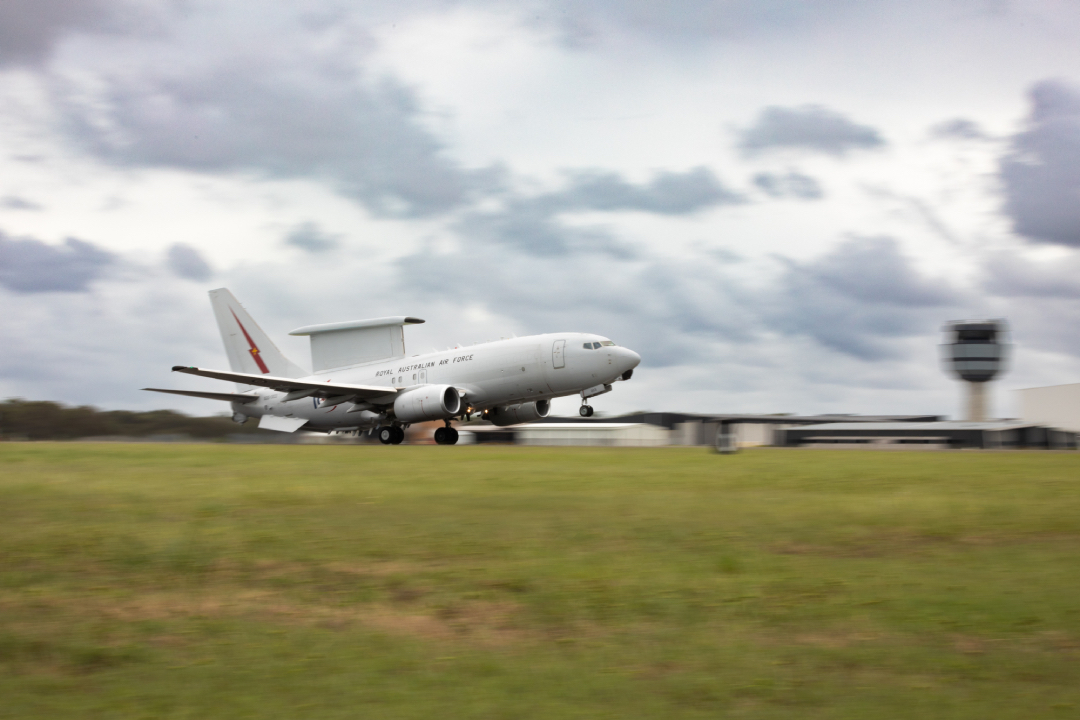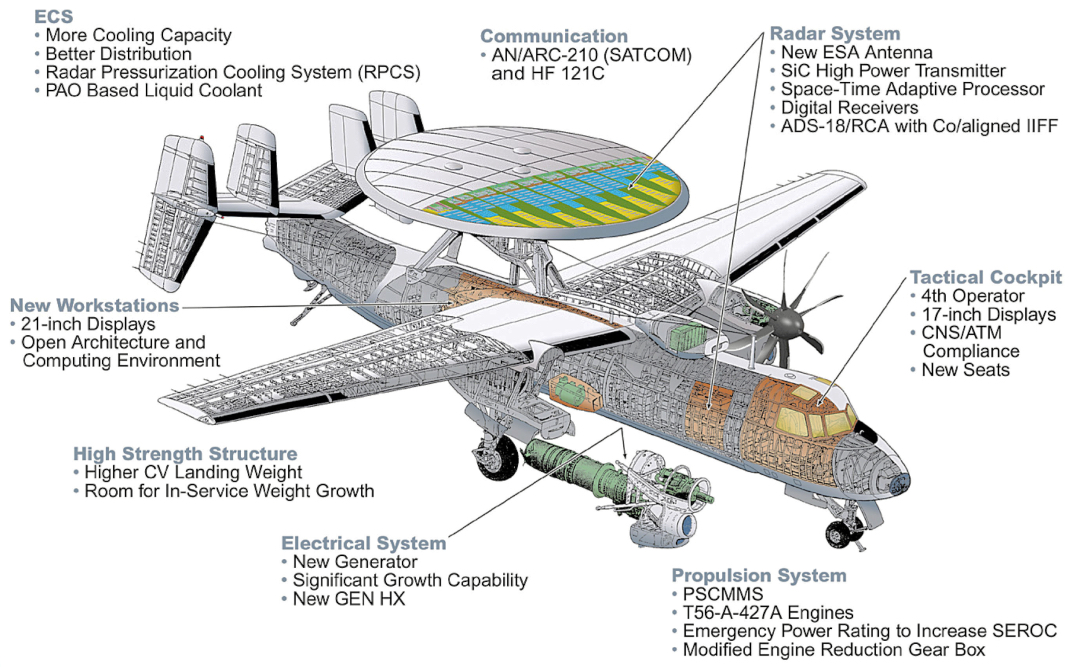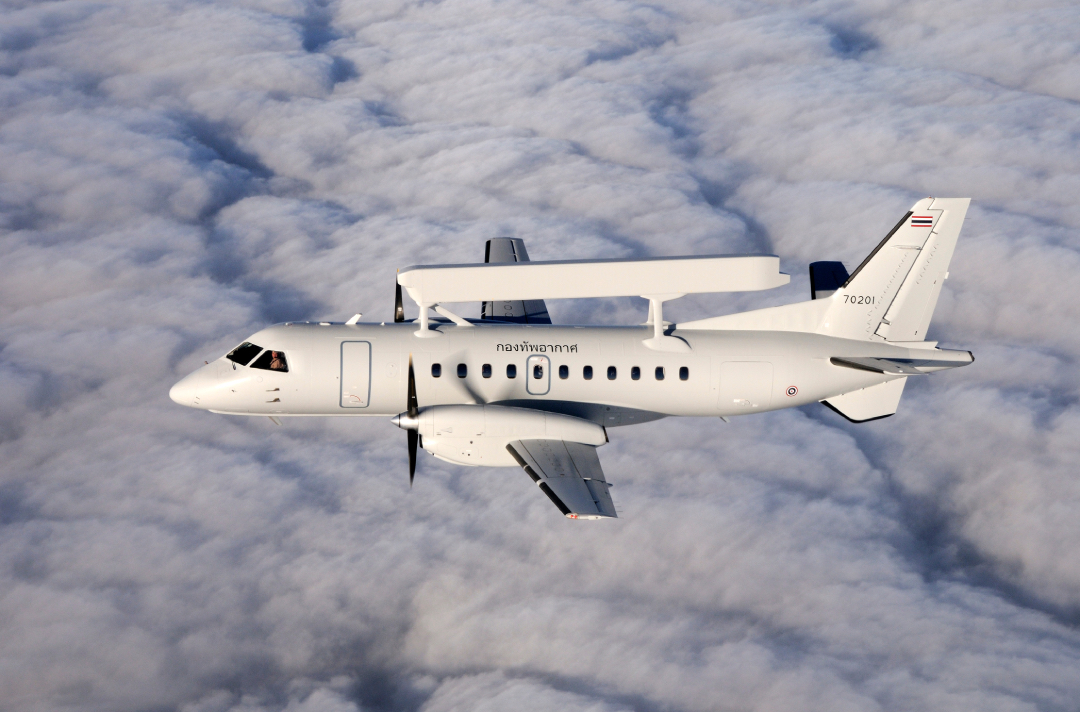Airborne Early Warning (AEW) aircraft operating in the Asia Pacific region.
From a purely West-centric view-point, it may come as something of a surprise to discover the extent of airborne early warning (AEW) technology and usage in the Asia-Pacific region. As this is being written, no less than eight Asia-Pacific countries: Australia, India (air force and navy), Japan, Pakistan, People’s Republic of China (air force and navy), Republic of China (ROC), Republic of Korea (ROK), Singapore and Thailand all have such capabilities, deploying 14 different types of air vehicle.
The air forces of Australia and the ROK have procured AEW capabilities that are based on the Boeing 737 airliner and are designated as the E-7A Wedgetail and the E-737 respectively. The generic, baseline, Boeing 737 AEW and control (AEW&C) makes use of a modified Boeing 737-700 Increased Gross Weight airframe that is powered by CFM56-7B turbofan engines and incorporates increased fuel tankage, a fixed dorsal radar antenna, air-to-air refuelling provision, the Boeing 737-800’s undercarriage and ventral stabilising fins. Internally, the Boeing 737 AEW&C offers multiple operator positions and has a mission system that centres on a Northrop Grumman L-band (1-2GHz) multirole electronically scanned array AEW and surveillance radar that has an integral identification friend-or-foe (IFF) capability with Mode S functionality. Other onboard equipment includes an automatic identification system application, a mission computing sub-system (with up to 10 operator consoles) and an integrated modular communications suite that can include high frequency (HF, 3-30MHz), very high frequency (VHF, 30-300MHz), very/ultra high frequency (V/UHF, 30MHz-3GHz), ultra high frequency (UHF, 300 MHz-3 GHz) and UHF satellite radios; an intercommunications system and tactical datalink provision.
Within the Royal Australian Air Force (RAAF), six E-7A Wedgetail aircraft (A30-001 through A30-006 inclusive) are assigned to the service’s No 2 Squadron at RAAF Williamtown, New South Wales, while the ROK’s 271 AEW&C Squadron operates a quartet of E-737 aircraft (64-700, 65-328, 65-329 and 65-701) from Gimhae in South Korea.

Boeing is also the source of the Japanese Air Self-Defence Force (JASDF) four E-767 airborne warning and control system (AWACS) aircraft (64-3501, 64-3502, 74-3503 and 84-3504). Based on the Boeing 767-200ER airliner, the E-767 is described as being an in-flight refuellable, all-weather surveillance, command-and-control and communications platform. Powered by a pair of CF6-80C2B6FA turbofans, the E-767 is flown by a crew of 21 (19 system operators) and is equipped with a mission suite that over time has included the AN/APY-2 surveillance radar; an upgraded CC-2E central computer; an AN/APX-103 IFF interrogator and an AN/APX-119 transponder; a total of 14 situation display consoles; dedicated communications and radar and computer display technician workstations; a nose-mounted weather radar; a pair of LN-100G navigation systems and a communications suite that includes HF, VHF and UHF voice (clear and secure)/digital data radios together with an Automatic Dependent Surveillance Broadcast Out capability.
Of these (and aside from a dedicated maritime mode), the E-767’s APY-2 radar is to radar system improvement programme (RISP) standard. RISP improves APY-2’s performance against aircraft and low radar cross section targets (such as cruise missiles) and introduces a new pulse compressed waveform that improves the radar’s sensitivity; an improved man-machine interface (with a fast fourier transform signals analyser in the radar control and maintenance panel); new general purpose adaptive signal processors (both using Ada software and replacing the existing radar data correlation and digital Doppler processing units respectively); enhanced data sampling rates and range/velocity resolution; better electronic counter-countermeasures provision and improvements in system maintainability and reliability.
The JASDF’s E-767s are operated by the service’s 602 Hikotai from Hamamatsu and as a functional equivalent of the American E-3 AWACS aircraft, it will be interesting to see whether Japan follows the US and launches an E-7 replacement programme for its E-767s.
Embraer AEW&D in India
Across the Indian Ocean, Embraer’s ERJ-145 regional airliner provides the airframe for one of India’s two indigenous AEW&C programmes (the other being a planned Airbus-based solution). As such, the ERJ-145 based EMB-145I (also termed the ERJ-145SM by one source) is the product of a consortium led by India’s Bangalore-based Centre for Airborne Systems and is designed to detect, identify and classify air threats, alert and direct interceptors, generate a recognisable air-surface picture and act as an airborne command/control centre that can support air defence and air strike operations.
EMB-145I systems and capabilities include an S-band (2-4GHz) primary surveillance radar (PSR); a CIT2500 IFF interrogator/transponder and/or a TXP600L Mk XII Mode S IFF transponder; radio and communications electronic support capabilities; a self-protection suite; a mission computer; a data handling and display system; an in-flight refuelling capability and a datalink capable communications system. Of these, the PSR is an active, electronically steered sensor that incorporates multiple integrated antenna arrays (IAA) that are housed in an 8.24m long plank-shaped fairing above the aircraft’s rear fuselage. The radar’s transmit-receive multi-modules (developed by the Hyderabad-based concern Astra Microwave Products) each incorporates eight transceiver modules, weighs seven pounds (3.2 kilogrammes), and measures 243×242×40 mm, with other features including a wide bandwidth at S-band, a high peak/low noise figure, pulsed power generation and digital switching, phase and amplitude control circuitry. For its part, each 19.5lbs (8.9kg) IAA offers integrated S- (radar) and L-band (IFF) functionality, measuring 704×900 mm and incorporates cavity-backed slotted elements and built-in test. Again, the system’s IAAs are MIL-STD-810E compliant and the radar as a whole is understood to be a fast-beam, agile system that can operate in several modes concurrently and provides search, track-while-scan together with priority and high performance tracking, with the latter being optimised for improved tracking accuracy. The priority tracking mode places targets in full track even if they cross the primary surveillance area.
For self-defence, the EMB-145I is fitted with a radar warning receiver, a missile approach warner and a countermeasures dispenser, while radar and communications band surveillance capabilities are available. The type’s mission crew is thought to number five and at time of writing, three EMB-145I aircraft (KW3554 through KW3556 inclusive) were being reported as being in service with the Indian Air Force’s (IAF) 200 Squadron based at Bhisiana Air Force Station in Punjab.
The Republic of Singapore Air Force’s (RSAF) four Gulfstream G550 conformal AEW (CAEW) aircraft (010, 016, 017 and 018) are G550 long-range business jets that have been modified to accommodate the Elta EL/W-2085 mission suite. Here, the architecture comprises a dual-band (L- and S-band) active electronically scanned array (AESA) AEW radar (with an integrated IFF capability), radar and communications intelligence sub-systems and six operator stations. Of these, the radar functions via forward and aft S-band arrays together with lateral L-band antennas, with the whole providing 360⁰ cover. Other features include flexible time-space energy management, selectable surveillance sectors, target verification, four second track initiation, a ‘track before detect’ capability and an optimised high value target tracking mode. Again, Elta describes this equipment as a ‘software’ radar many of whose functions (such as sidelobe management and waveform generation) are software driven.
Overall, EL/W-2085 is described as being fully automatic and produces fused and unified sensor data for its operators. In RSAF service, the G550 CAEW is assigned to its 111 Squadron that is based at Tengan in the western part of the country.

Russia’s Ilyushin Il-76 transport aircraft is the basis of two Asia-Pacific AEW platforms, namely the PRC’s KJ-2000 and India’s A-50EhI. In order, the KJ-2000 (NATO ‘Mainring’) is an indigenous AEW&C platform that is based on the airframe of the Il-76MD. As such, the capability has been credited to both the Nanjing Research Institute of Electronic Technology and the China Electronics Technologies Corporation’s 38th Research Institute, with the Xian Aircraft Company undertaking the necessary installation work. External features include a fixed dorsal rotodome (approximately 11m in diameter), a ventral navigation radar, a dorsal satellite communications radome, twin stabilising fins beneath the aircraft’s rear fuselage, deletion of the Il-76MD’s tail turret and an array of six blade aerials above its forward fuselage.
The KJ-2000’s radar makes use of fixed arrays within the rotodome to provide 360⁰ coverage and the aircraft is flown by a crew of at least 15, at least 10 of whom are mission system operators. At the time of writing, the People’s Liberation Army Air Force (PLAAF) is understood to have been operating four KJ-2000s (30571 through 30574 inclusive), with the quartet being assigned to its Eastern Theatre Command’s 77 Regiment at Wuxi/Shuofang in China’s Jiangsu Province.
India’s trio of A-50EhI aircraft (KW3551 through KW3553 inclusive) are the product of a Russo-Israeli consortium that is made up of Beriev (airframe and avionics) and Israel Aerospace Industries (the Elta EL/W-2090 mission system). Platform features include an 11.5m diameter fixed rotodome (containing three fixed transceiver arrays that give 360⁰ coverage), an in-flight refuelling capability, 11 operator consoles and a Russian sourced communications suite that includes HF, V/UHF and super high frequency (SHF, 3-30 GHz) radios together with satellite communications provision.
For its part, EL/W-2090 includes an L-band AESA radar, radar and communications band intelligence receivers (served by four interferometric antenna arrays) and self-protection and IFF sub-systems. Of these, the IFF capability may incorporate a Thales-sourced interrogator and the Bharatiya Vayu Sena’s Indian Air Force) A-50EhIs are operated by the service’s 50 Squadron based at Agra in Uttar Pradesh. In addition to the three cited aircraft, India is known to have ordered an additional pair of A-50EhIs. Whether or not this order has been/will be consummated remained uncertain at the time of writing.

Both the Chinese and Indian Navies operate the two person Kamov’s Ka-31 (NATO ‘Helix-E’) radar picket helicopters. At the centre of the capability is the Joint Stock Company Nizhny Novgorod Research Institute of Radio Engineering’s L-band E-801 Oko (Eye) surveillance radar, which the Indian aircraft team with a multi-screen display suite, a PNK-37DME flight and navigation system, a communications package (including V/UHF band radios and an air-to-surface datalink), an auxiliary power supply and a flight recorder.
Looking at the export version of the E-801 radar in more detail, the set has a detection range of up to 134 nautical miles (250km) and 80nm (150km) against a fighter-sized target and out to the radar horizon against surface ships); can be operated at altitudes of up to 11,483 feet (3,500m) and makes use of a 440lb (200kg), ventrally mounted, passive phased-array antenna that folds through 90° to lie flat along the helicopter’s centreline for take-off, landing and, most probably, cruise flight. In terms of usage, Indian Navy Air Squadron 339 is understood to operate at least 14 Ka-31s (IN561 through IN569 and IN721 through IN725 inclusive) from its home base at Dabolin in Goa, while at least 10 are assigned to the People’s Liberation Army Navy’s (PLAN) 11 Air Regiment which is home based at Ningbo in China’s Zhejiang Province.
Hawkeye Upgrades
Returning to the fixed-wing domain, land-based variants of Northrop Grumman’s E-2 Hawkeye AEW&C aircraft are operated by the JASDF and the ROC. Of these, the JASDF operates a mix of upgraded E-2C Group O and E-2D platforms, with the former having had their original AN/APS-138 radar, Enhanced High-Speed Processor configured L-304 mission computer, ‘core’ IFF system, main display units and 10- to 12-ton cooling system replaced. The new systems were the AN/APS-145 sensor, a 15 ton cooling system and the E-2C Hawkeye 2000’s Mission Computer Upgrade (MCU), IFF system, Advanced Control Indicator Set (ACIS) display suite and a 15-ton cooling system. Other enhancements included the introduction of the AN/ASN-139 Carrier Aircraft Inertial Navigation System II, an upgraded Automatic Flight Control System (AFCS) and an ongoing effort to install the E-2’s latest eight-bladed propeller.

As originally supplied, Japan’s E-2C Group O aircraft’s mission/avionics suite also included Main Display Unit operator consoles, the AN/ALR-73 Passive Detection System (PDS) and a communications suite that was made up of two HF, three V/UHF, and three UHF band communications radios. Of these, the upgraded aircraft retain the AN/ALR-73 PDS and the communications radio package from the original mission suite and the upgrade has also been associated with the E-2 Engineering Change Proposals-411R1 and -422R1.
For its part, the E-2D is the latest evolution of the Hawkeye line and differs from its predecessors by virtue of its introduction of T56-A-427A turboprop engines (with eight-bladed NP-2000 propellers); the AN/APY-9 surveillance radar, the AN/APX-122 IFF interrogator and the AN/ALQ-217A electronic support measures system; a new tactical cockpit (which enables the aircraft’s co-pilot to act as a mission system operator when required); a flight management system; an enhanced environmental cooling system; revised operator workstations; increased structural strength and an upgraded mission computer, navigation suite and communications system (including a multifunction information system low volume terminal).
Perhaps the most significant of these innovations is the 2,200lb (998kg) AN/APY-9 radar that features an ADS-18 antenna that scans electronically in azimuth (in 120⁰ instantaneous sectors) and mechanically in elevation. Other system features include use of a digital receiver, space-time adaptive processing, in-beam stagger, a solid-state transmission chain, simultaneous air and surface detection, improved interference cancellation and a commercial off-the-shelf processing architecture.
At the time of writing, the JASDF was operating 12 E-2C (34-3451 through 34-3461 inclusive, 44-3426, 44-3463, 54-3455, 54-3457 and 54-3458) and three E-2D (91-3471, 01-3473 and 01-3474) aircraft that are assigned to the service’s 601 (E-2C and D) and 603 (E-2C) Hikotai based at Misawa and Naha respectively.
For its part, the ROC’s six E-2K aircraft (2501 through 2506 inclusive) are export versions of the E-2C Hawkeye 2000. Powered by T56-A-427 turboprops, the E-2K weapon system includes the AN/APS-145 surveillance radar, the AN/APX-100(V) IFF transponder, a PDS, the MCU architecture, ACIS tactical displays and a communications suite that is made up of two HF, three AN/ARC-182(V) ‘Have Quick’ and three UHF band radios; Link 4A, 11 and 16 datalinks; a satellite communications capability and (possibly) Multi-mission Advanced Tactical Terminal and AN/URC-107(V)4 Class 2H Joint Tactical Information Distribution System terminals. As of this writing, the ROC’s E-2Ks were assigned to its air force’s 2nd Early Warning Squadron (designation to be confirmed) based at Pintung South airfield on Taiwan.
Saab’s L-band Erieye AESA surveillance radar is at the heart of the mission suites installed aboard Pakistani Saab 2000 AEW&C and Thai Saab 340 AEW aircraft. In reverse order, Thailand’s pair of Saab 340 AEW aircraft (K1-1/53 and K1-2/55) are ex Swedish Air Force S 100Bs that (in Swedish service and aside from their Erieye radars and their 9.7m dorsal ‘plank’ antennas) were equipped with the TSB 2500 IFF system, an HF/VHF/UHF communications package, a colour weather radar, an AFCS, an integrated global positioning system (GPS)/inertial navigation system, an instrument landing system and accommodation for a flight crew and an in-flight radar technician. So configured, the S 100B functioned as a ground-controlled sensor that down linked the acquired radar picture to one or more command centres. Thailand’s Saab 340 AEWs are thought to operate in the same way and are assigned to the Thai Air Force’s 702 Squadron at Surat Thani in southern Thailand.
Currently, the Pakistan Fiza’ya (Pakistani Air Force) is thought to operate a total of seven Saab 2000 AEW aircraft (09-049, 10-025, 10-040, 11-045, 18-060, 19-061 and 20-057) which are derived from the Saab 2000 regional airliner, are powered by a pair of AE 2100A turboprops and are equipped for airborne surveillance and command and control. Other system features include the Erieye’s ‘plank’ antenna, cabin-mounted fuel tanks, a five position operator’s console, a voice and datalink communications package, a Saab-sourced IFF system, Saab’s HES-21 combined electronic support and self-protection suite and a main cabin active noise cancellation application. In Pakistani service, the country’s Saab 2000 AEW fleet is operated by the Air Force’s 3 (AEW) Squadron based at Minhas in the Punjab.
The remaining platforms covered by this survey (the PRC’s KJ-200 and KJ-500 aircraft together with Pakistan’s ZDK-03) are Chinese-sourced and are all based on Shaanxi Y-8 and Y-9 derivates of the Russian Antonov An-12 turboprop transport aircraft. In the order given, the Y-8 based KJ-200 made its maiden flight on 8 November 2001 and is externally characterised by a 6m long by 0.75m deep dorsal ‘plank’ antenna for its phased array surveillance radar. Here, the radar is understood to be an indigenous equipment that was developed by the China Electronics Technology Corporation’s No38 Research Institute at Hefei in China’s Anhui Province, while other onboard avionics may include a weather radar, a GPS-based navigation system and an instrument landing system. At the time of writing, the KJ-200 was in service with both the PLAAF’s 26 Division and the PLAN’s 2 Division, with aircraft of the type being based at Laiyang (in coastal Shandong) and Wuxi/Shuofang.
The Y-9 based KJ-500 is equipped with another No 38 Research Institute radar whose trio of electronically scanning antenna arrays are housed in a fixed dorsal rotodome. Other external features suggest that the aircraft is fitted out with a signals intelligence capability and like the KJ-200, the KJ-500 is in service with both the PLAAF and the PLAN. Over time, aircraft of the type have been associated with a range of airfields including Laiyang, Lhasa/Gonggar (Tibet), Lingshui (Hainan Province), Lushan (Jiangxi Province), Shanghai/Dachang, Shigatse/Xigazê (Tibet), Wuxi/Shuofang and Yongsh Dae on the Fiery Cross Reef.
The remaining member of this trio is the Y-8 based ZDK-03/KE-03 Karakoram Eagle which has been supplied to Pakistan. Like the KJ-500, the ZDK-03/KE-03 is equipped with a Chinese surveillance radar whose antenna array is mounted in a dorsal rotodome. Whether this is fixed or rotates remains uncertain. The Pakistani Air Force is understood to operate a total of four ZDK-03/KE-03 aircraft (11-001, 12-002, 13-003 and 14-004), all of which are assigned to the service’s 4 (AEW) Squadron based at Masroor in Sind Province. Little is known about the ZDK-03/KE-03’s mission suite other than it is claimed to “work well over sea, plains and mountainous terrain”.
by Martin Streetly





















Discussion about this post